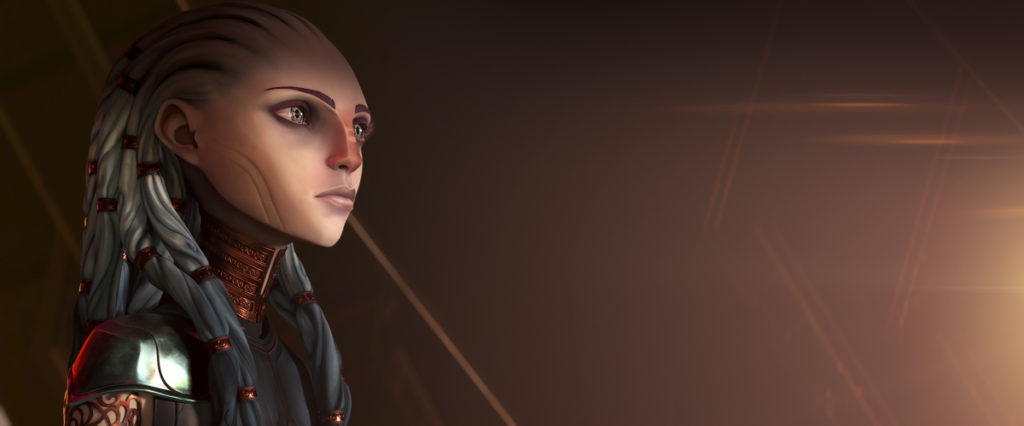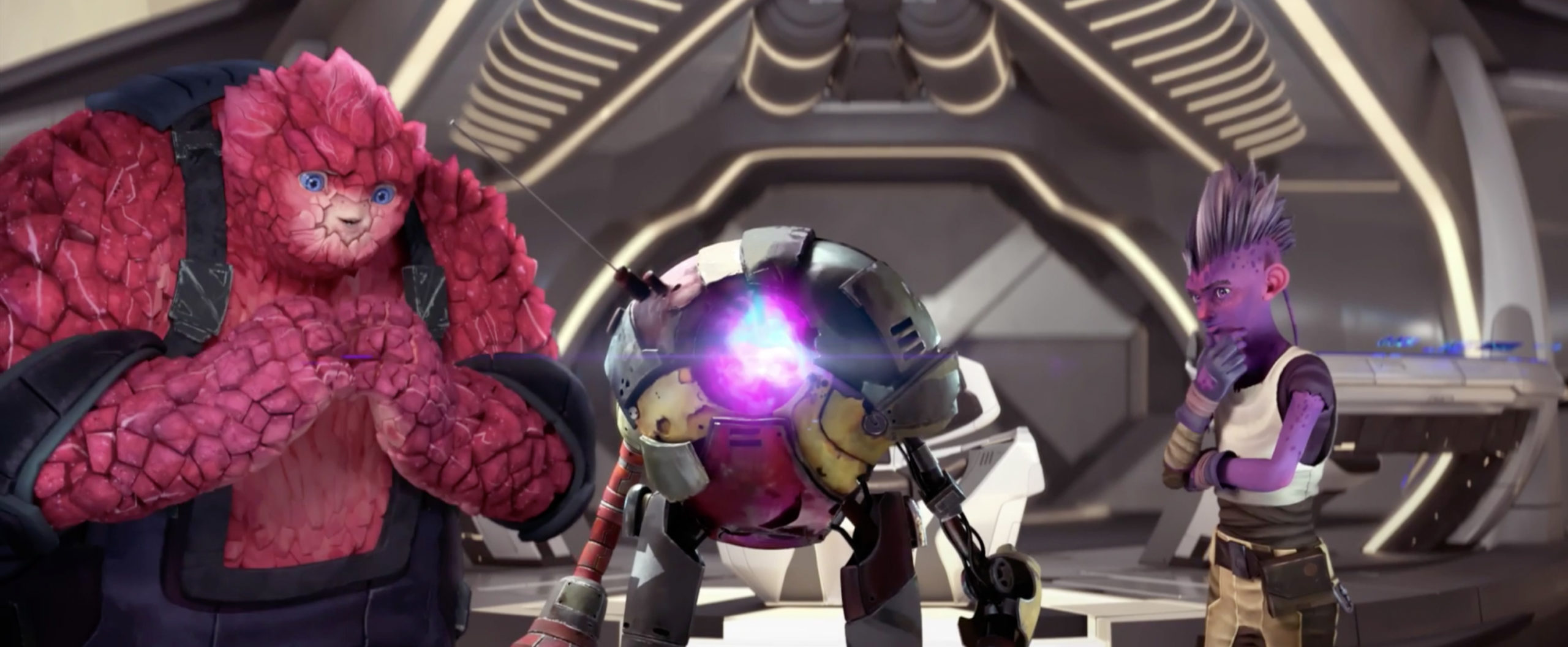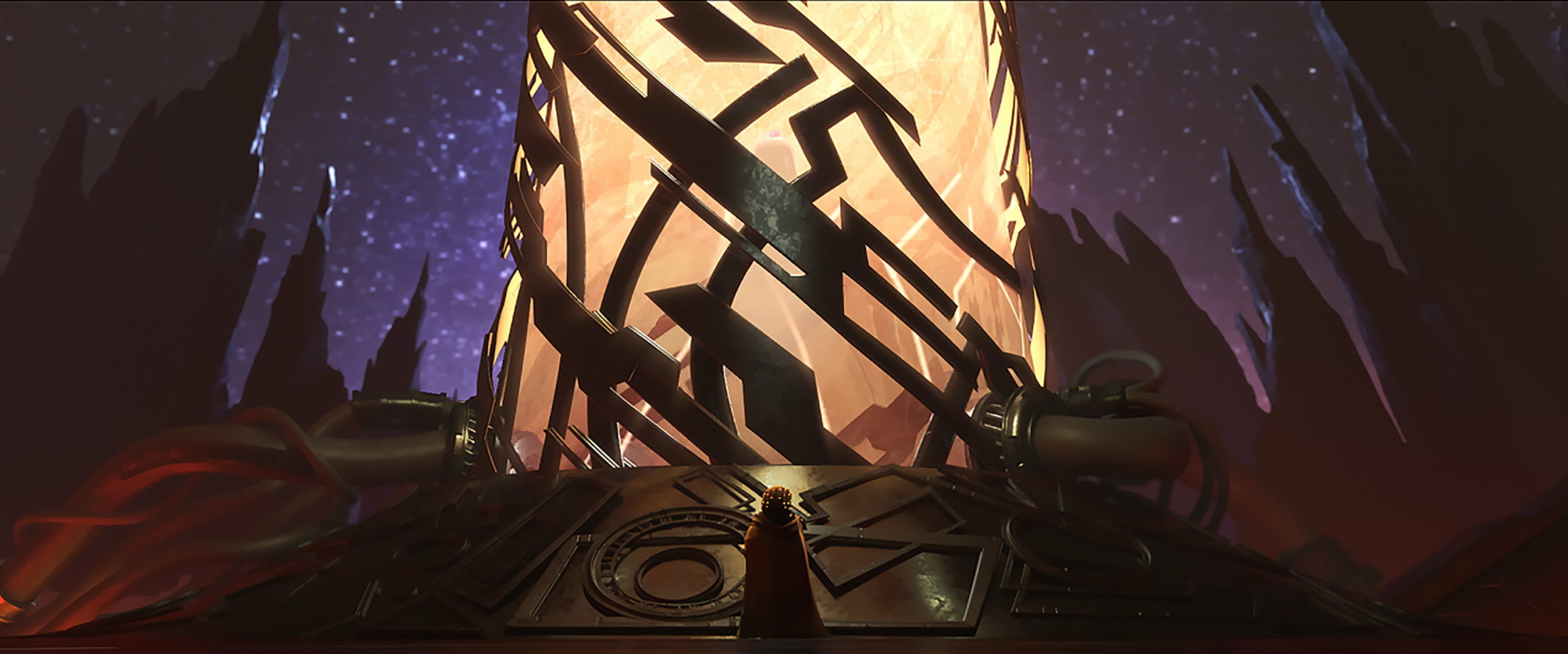Watching the Star Trek: Prodigy pilot, I could not help but feel I had heard this story before. I mean this lovingly, as I would for the great sci-fi that manages to handshake lost millennia via the broad strokes of its plot and themes, all while preserving its own distinctiveness. In this case, Star Trek: Prodigy’s first episode, “Lost & Found,” gave us a unique echo of 413 B.C.E., when Euripides created his own story of those lost then found, Iphigenia in Tauris. Whether by creator intent or the natural intermingling of mythos, this relationship between these two texts provides a great example of Star Trek doing what it does best: making the old new again.
Since we already have a great recap of “Lost & Found,” I’ll trust you to either be already familiar with that, or know the episode’s plot straight from the source. Either way, consider yourself forewarned of spoilers ahead.
In case your Euripides days are farther in the past, though, let me give you the nutshell of Iphigenia in Tauris: Iphigenia, tossed onto the distant island of Tauris by Artemis (in order to save her life; which all happens in a different play, Iphigenia at Aulis), finds herself tasked with the gruesome job of ritually sacrificing foreigners that wash up ashore, which she hates. The king of Tauris, Thoas, is ruthless and holds Iphigenia captive, so, through a series of events, she executes a plan to escape with the help of some of the very people she is meant to execute.
That is a very, very distilled version of the plot, but I’ll dive into more specifics as I make my case for its ancestral resemblance to “Lost & Found.” Tonally, the play is at once comedic, melodramatic, and deeply affecting. Prodigy, too, seems to be striking a similar tone, with its emotional core contained by earned laughs and honest tension. While these components make Prodigy ideal for a younger audience, I believe the same could be said for a modern version of Tauris, which perhaps, on the whole, makes this ancient text a natural choice for today’s children’s media.
But let’s zoom in on the episode “Lost & Found.” Early on, we meet Gwyn, a Vau N’Akat 17-year-old, who is on a mining world that seems distant to her, despite being her home. Daydreaming about life among the stars, Gwyn performs the miserable duties assigned to her by her father: Intake new enslaved populations, pursue escapees, and hunt for Fugitive Zero. Iphigenia would recognize this conflict between where Gwyn wants to be and the cold reality of her day-to-day. Though Iphigenia might urge Gwyn to make a break for it earlier, Gwyn does her best to conform. Her ideations of liberation are fleeting, and she remains focused on her father’s goals. Using Iphigenia as a model, though, I would not be surprised to see Gwyn move farther from this as the episodes progress, especially now that she is stuck with Dal.

Pictured: Ella Purnell as Gwyn of the Paramount+ series Star Trek: Prodigy . Photo Cr: Nickelodeon/Paramount+ ©2021, All Rights Reserved.
Rebellious and headstrong Dal, of an alien race unknown, brings with him his own connection to Iphigenia in Tauris that, if maintained, could only lead to Gwyn’s rejection of her warden dad. Dal is a prisoner on Gwyn’s planet. He has washed up there for reasons unclear to us, but makes it known from the get-go that he has no intention of sticking around. It’s Gwyn’s job to keep him in line, and catch Fugitive Zero (perhaps even using Dal to do it), but, by the end of “Lost & Found,” she has failed on both counts, possibly to her own benefit later, thanks in part to Dal’s cleverness. In Iphigenia in Tauris, a similar character, Orestes, is captured by Taurian guards trying to steal a statue of Artemis. The Taurians imprison Orestes, and will sacrifice him shortly if he cannot escape. Needless to say, he intends to. Like Dal, Orestes is determined perhaps to a fault (he has, previous to this play, killed his mother to avenge his father). Iphigenia is about to kill Orestes, as ordered by Thoas, when she, in a move so true to Ancient Greek form, discovers Orestes is, in fact, her brother. (The play explains why she didn’t recognize him sooner, but all that matters, here, is that the discovery comes at just about the last moment.) Unable to execute her sibling, Iphigenia and Orestes realize that they must leave Tauris, and they need the same thing that Dal does in Prodigy to do it: a ship.
Dal and Rok-Tahk find the Protostar on a whim, and then, with a team, restore it to (roughly) working order. Orestes also finds his ship with his loyal friend, Pylades, though they had arrived to Tauris with it, and intended to use it as a getaway vessel. Despite this difference, both crews overcome a series of tense obstacles (though, for Dal and company, more pew-pew is involved) to get to their ships, and then use them to sail/soar off into the unknown for their final acts.
Of course, it is worth noting that Iphigenia is an active participant in this prison break. Gwyn is not. She leaves on the Protostar tied to the captain’s chair, attempting to carry out her mission to the bitter end. This difference exists because of the types of modes that carry these texts. A play like Iphigenia in Tauris wants to be wrapped up by its final tableau, with sequels coming out years later, if at all. Star Trek: Prodigy is a TV show, and needs to take more time showing characters, especially the daughter of the big-bad, coming around to a perspective that is the complete photonegative of where they started, or deciding to maintain course and be a thorn in the Protostar’s side wherever they may go.
However, on their bold voyages, both vessels go with a blessing. In Tauris’ final moment, the goddess Athena springs up over the ship, deus ex machina style, and gives the crew a favorable wind and instructions on what to do with the statue of Artemis (yes, Orestes can’t let that go), while making King Thoas call off his attack and free the other enslaved people of the island. When the ethereal hologram of Captain Janeway emerges from the Protostar, she brings with her a similar feeling. Janeway is there to instruct the ragtag crew, give them as much of a favorable wind as she can in space, and ideally help them overcome their own King Thoas, who still holds an entire planet in slavery.
Through Prodigy’s Diviner, we learn that freedom can’t happen in a single episode. That’s a bigger mission. However, the end of it may owe its success to the Protostar’s own deus ex machina, Janeway. We know that both the enslaved people of Tauris, portrayed by the play’s chorus, cheer on and support the escaping crew, much like the population of the mining planet applauds Dal’s jailbreak. With groups on both “islands” eager for liberty, each’s dictator has reason to sweat both god and mortal alike.
Star Trek frequently adds its diversity to Ancient Greek works. Many of Star Trek: Discovery’s season one episodes drew upon Homer’s Odyssey, going so far as to swipe some of the epic’s lines as titles. The original Star Trek series found myriad Ancient Greek texts helpful in its stories, even going so far as to call upon Apollo himself. In Iphigenia in Tauris, Star Trek: Prodigy has found a reliable ancient text upon which to base its first season. There may be, and indeed already are, key differences between the two stories, but even a vague closeness can give Prodigy lots to work with. It can play to the humor of an unlikely pair, Dal and Gwyn, finding common ground as figurative siblings, if in fact the future episodes play that out. It can lean into the wonder of a new crew guided through places no one has gone before by a familiar “god” in Janeway. Most of all, it can access the heart of Iphigenia and show that wanting to trade circumstance for agency is a struggle that has endured thousands of years on this planet, and countless more, surely, on others. In Star Trek: Prodigy, new audiences will see an ancient tale made current, and perhaps that is the most Star Trek thing it could do.


